Slim and light, with excellent battery life. The ASUS TUF Dash F15 is ideal for gaming on the go
- Manufacturer: ASUS TUF
- Model: Dash F15 FX516PR
- Price when reviewed: £1299.99
- Supplied by: ASUS
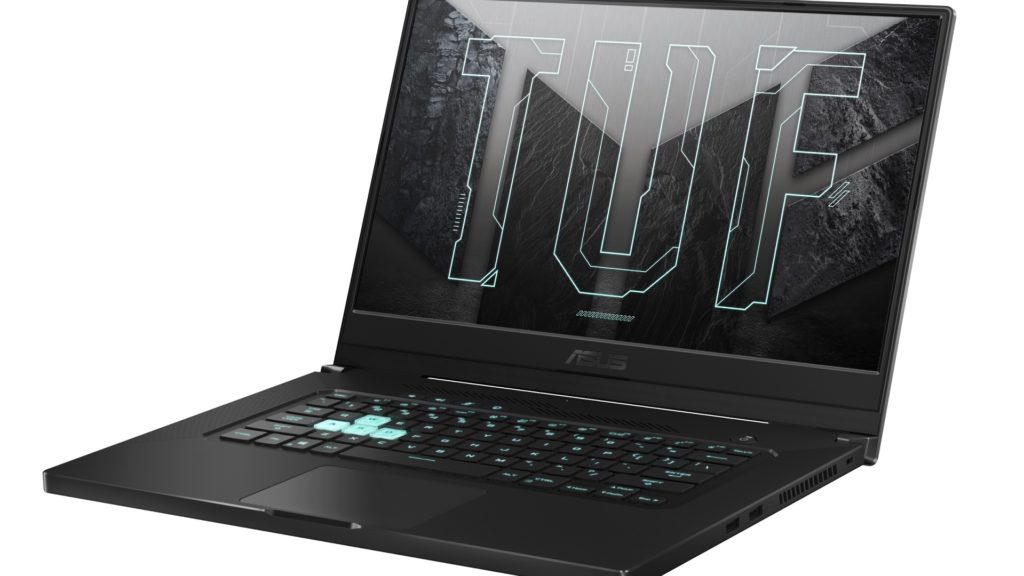
Overview
If you aren’t familiar with the range, TUF is ASUS’s attainable brand of gaming laptops. Sitting comfortably at the affordable end of the price range, they bring big performance at a great price. The cost of the various models of the TUF Dash F15 is still very reasonable, but not only is the build quality better than ever, we have the introduction of the RTX 30-series GPUs and 11th Gen Intel Core i7 CPUs. There have been a couple of concessions made to keep the cost down, but they have also eked out the longest battery life of any laptop we’ve seen.
Design and build
The first and most significant improvement of the TUF Dash F15 is the switch to metal for the top of the lid. Not only does this give the laptop a more premium feel, but it has also greatly increased the rigidity of the display, which had a tendency to feel a bit flimsy on the older TUF laptops. The hinges mounting the display hold the display firmly in place, but it is still possible to lift the display one-handed without the body of the laptop lifting, too.
Build quality of ASUS’s laptops has never been an issue, especially their TUF range, which are designed to handle temperature, humidity and minor bumps and knocks without any concern. The rest of the Dash F15’s shell is plastic, but it feels very robust and there’s very little flex. Panel fitment and general assembly quality are superb, and beyond what you’d expect from more affordable ranges of laptops.
The TUF Dash F15 has a welcomely small power adapter. Unlike some other devices I’ve tested recently, the main length of the cable goes from the adapter to the laptop, so there were no issues with keeping the adapter on the floor and out of the way, and there’s enough cable to comfortably reach your desk, the sofa, bed or pretty much anywhere else you want to use it.

In terms of design, there are a few flourishes to mark this out as a gaming laptop, but for the most part, it’s a relatively understated design. There’s plenty of ventilation at the sides, rear, and back of the keyboard deck, but they are subtly integrated rather than stand-out design pieces. Our review model has a black keyboard deck and lower shell, while the metal lid is a very dark shade of gunmetal-grey. There is a huge TUF logo on the lid, but the black lettering against the dark background blends in well and prevents it from looking garish. (ASUS also sell a variant of the TUF Dash F15 in Moonlight White, which looks gorgeous.)
Bezels around the display are minimal, with even spacing at both the sides and the top. This is possible because the Dash F15 doesn’t have a webcam built-in, which they seem to have removed from most of their 2021 range. In fairness, webcams on laptops are usually 720p and have mediocre quality, but with video conferencing being used a lot more often these days it’s still a surprising omission. You can pick up a cheap webcam that clips to the top of your display or use software that lets you use a smartphone as a webcam, so not having a webcam doesn’t bother me, but it’s worth pointing out.
A pair of 2W speakers are fitted to the Dash F15, and they’re perfectly acceptable for light media consumption if you don’t have a headset or set of speakers handy. Bass is typically underrepresented, and treble lacks a touch of clarity, but performance is just above what you’d expect from a laptop. Loud fan volume can drown out the speakers, though, so you will definitely need a headset while gaming.
I’m definitely a fan of ASUS’s 2021 design revisions. They’ve removed the unnecessary angular corners that the TUFs used to have and toned down some of the more aggressive styling, which gives the laptop a clean and more professional appearance.
The TUF Dash F15 is very thin at just 19.9 mm and also very light, weighing around 2Kg. Combined with the MIL-STD military standard durability certification, the Dash F15 is a great choice if you travel or frequently move your laptop around with you. I’d happily chuck it into a backpack and take it with me pretty much anywhere.

Keyboard and trackpad
As much as I appreciate an ultra-thin device, it does come with some drawbacks. Despite there being plenty of surface area for a full keyboard arrangement, making the laptop so thin means ASUS has had to fit a TKL layout to the Dash F15. This in itself isn’t a problem, however, I do have a couple of niggles with some of the choices they’ve made. First of all, the arrow keys are tiny, only half the height of regular keys, making them a bit awkward to use. The enter key is also smaller than I’m used to, with single key height and double-width, again making it awkward to hit consistently. Finally, there is no insert or print screen key, the latter of which, as a games journalist, obviously comes in very handy. There is a screen-snip shortcut bound to Fn+F6, but it’s not as convenient as a straight screen-grab.
These minor complaints aside, the actuation depth (key travel – 1.7mm) and typing feel of the keys is well balanced and quiet, making writing and gaming on the keyboard a pleasure. ASUS has also fitted a few extra buttons for convenience. There’s a separate dedicated power button, and a bank of four hotkeys for volume up/down, mic mute and a shortcut to launch Armoury Crate. I love the convenience of the volume controls and not having to use an Fn key combo, but I think we’d be better served by a volume mute as opposed to a mic mute switch.
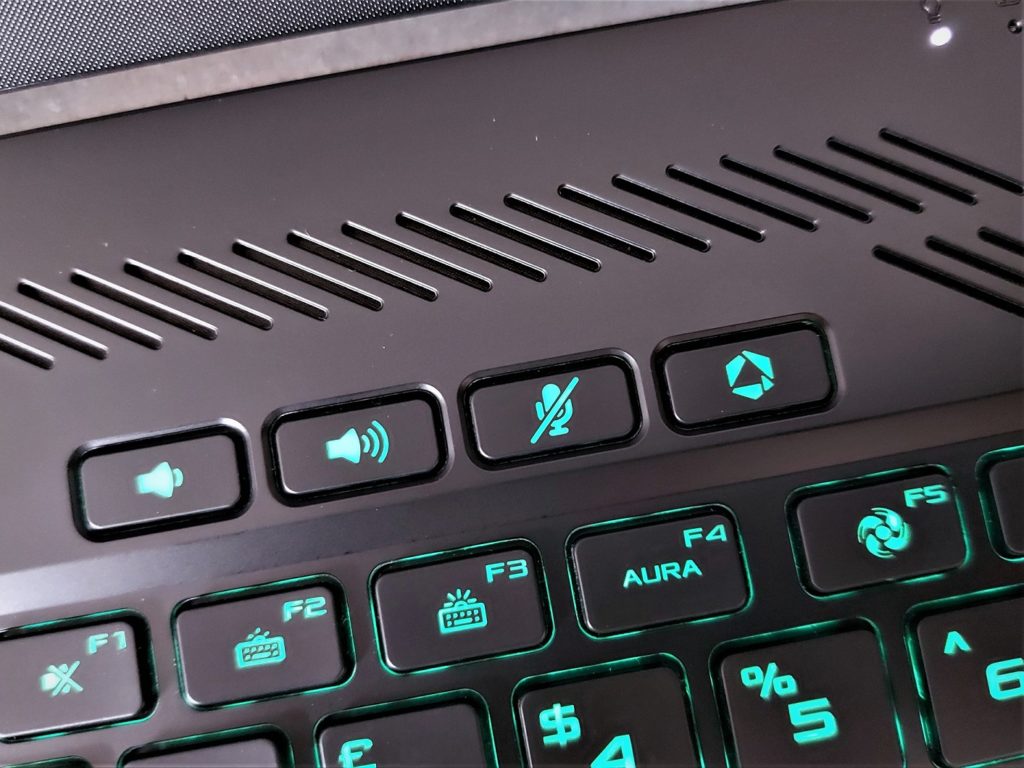
The keyboard itself is LED-backlit in Bolt Blue (a light teal, to you and me), which is a unique and pleasant colour. It gives a soft surround to the keys and passes through the translucent lettering which is both easy on the eye and provides clear key identification. For gamers, the WASD keys are fully translucent, standing out boldly against the other keys. The only downside to the backlit keys is that if you have the backlight turned off, it’s nigh-on impossible to read some of the keys in low light conditions. Fortunately, the backlight isn’t intrusive, so there’s no problem just leaving it switched on.


Located in the centre, under the keyboard, is the trackpad. It’s much larger than in previous TUF laptops, extending right to the front of the case. The surface is smooth, enabling accurate pointer control, and I found the multi-finger gestures and taps to work reliably. The under-surface LMB and RMB buttons feel a bit clunky, but it’s far easier to just tap or two-finger tap. There is occasionally a slight dead-zone at the outer edges of the touchpad, but it didn’t cause me any problems.
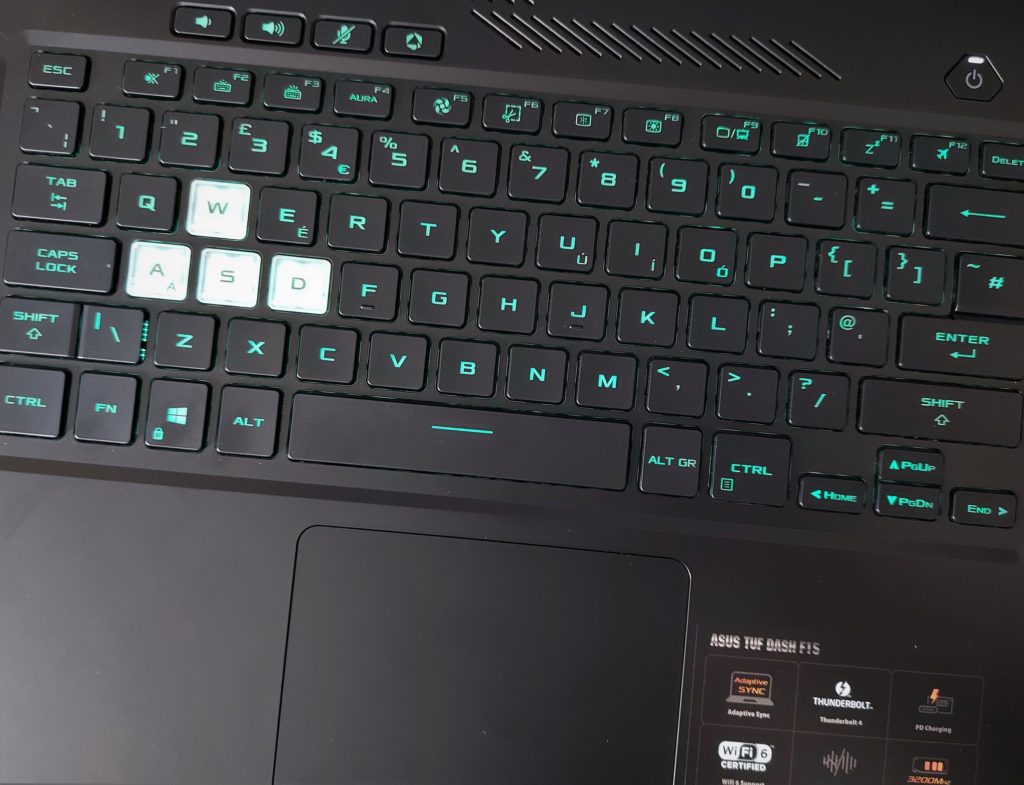
Connectivity
- 1x 3.5mm Combo Audio Jack
- 1x HDMI 2.0b
- 3x USB 3.2 Gen 1 Type-A
- 1x RJ45 LAN port
- 1x Type C USB 4 supporting DisplayPort / power delivery / Thunderbolt™ 4
Most of the connections run along the left side of the laptop, apart from a pair of USB-A 3.2 ports on the right. This works out fine for general use – I’ve seen HDMI ports placed along the right side, which gets in the way as it’s harder to move the thicker cables out of the way, but the Dash F15 worked out well for the wireless receivers for my mouse.and keyboard.


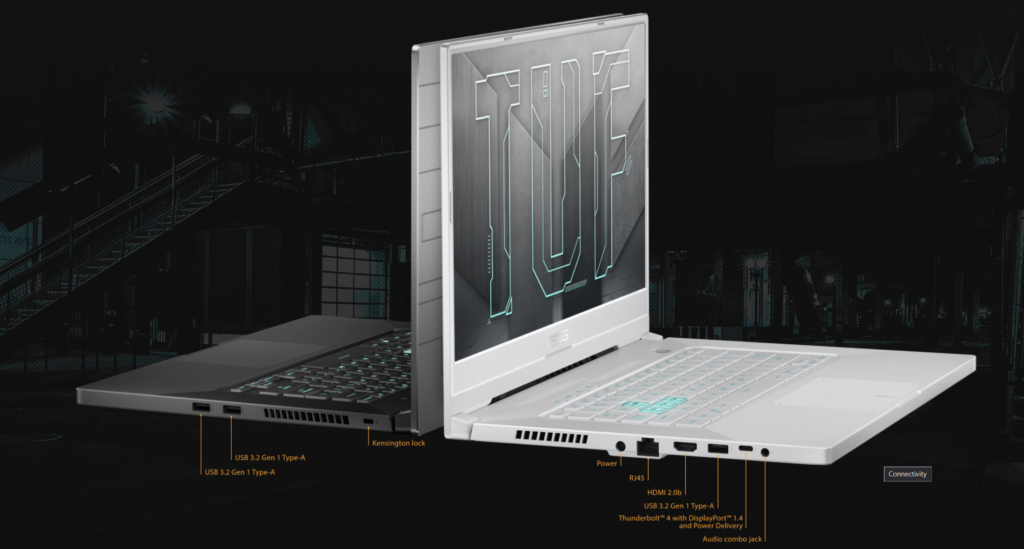
Screen
The TUF Dash F15 is available with three different 15.6” displays:
FHD (1920 x 1080) Value IPS, 144 Hz, 62.5% sRGB, 47.34% AdobeRGB, Adaptive-Sync
FHD (1920 x 1080) IPS, 240 Hz, 100% sRGB, 73.35% AdobeRGB, Adaptive-Sync
WQHD (2560 x 1440) IPS, 165 Hz, 100% sRGB, Adaptive-Sync
Our review model came with the 1080p 144 Hz display, which is a good match for the performance of the laptop, but I found the colour vibrancy to be underwhelming.
Contrast levels are reasonable, and above average for what you’d expect of an IPS display. Peak brightness is fairly low at around 275 cd/m2. Despite this, dark scenes still showed a decent amount of detail, with no notable black crush, while still able to push out decent highlights and bright images.
Brightness uniformity was good, with an average brightness distribution of 93%, with the biggest drops at the top-centre and bottom-centre of the display, however, this was barely noticeable at a regular usage distance while centred to the screen.
Colour quality was distinctly lacking, though. I like to use Futurama as a test for colour vibrancy, consistency and uniformity, as the large swathes of colour and subtle gradients are good for showcasing the quality (or lack thereof) of a display. While the uniformity was good, with colours remaining consistent across large areas, the screen lacks any punch, and images look washed out. It’s not a bad image, per se, as apart from the colour vibrancy, the display is acceptable and more than usable, but unless you are on a very restrictive budget I’d definitely recommend opting for the 240 Hz 1080p panel with 100% sRGB coverage.
The 1440p display is a tempting option, but the increased resolution won’t be as significant on a 15.6” display, and as we will see in the performance benchmarks, running at 1080p yields better results, especially in terms of future-proofing your purchase, as games are only going to get more demanding in the years to come
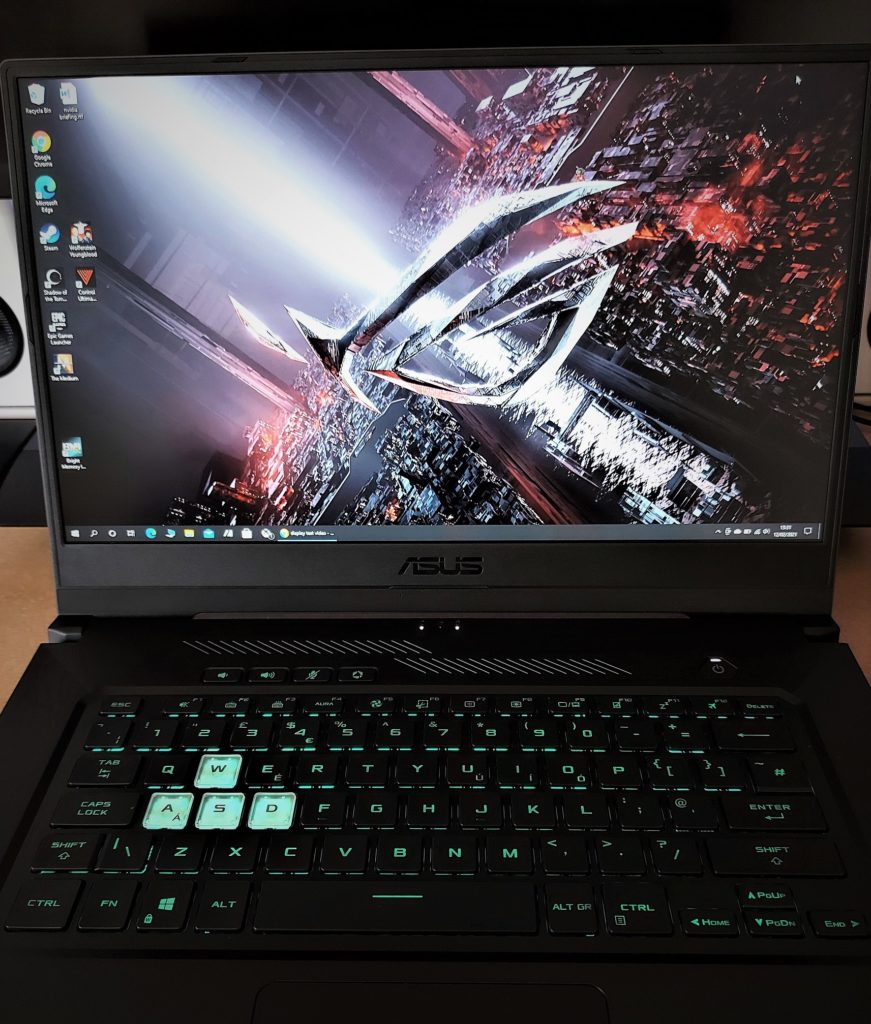
Performance
This was my first experience of both the new RTX 3070 GPU and the i7-11370H CPU, and the results have been mostly very good, even if it’s not as much of an improvement as I expected. Although there were a few games that showcased the potential of the improved ray-tracing capabilities of RTX 30-series cards, I found many games performed roughly similar to a laptop we tested which had an RTX 2070 Max-Q and i7-10750H pairing. You can pick up the TUF Dash F15 for just £1299.99 in the spec we received, though, which is comparable to or even cheaper than the RTX 2070 equipped devices, which makes the Dash F15 more desirable for its excellent battery life and improved ray-tracing capabilities.
Without the Max-Q branding on mobile GPUs, it’s not immediately clear what performance you can expect from the new cards. Manufacturers should display the TDP rating for their GPUs on their product pages, which will make it easier to compare the performance of devices at a glance (it’s not yet known if retailers will have to follow the same standard, however, ASUS have already updated their product pages). The RTX 3070 in the Dash F15 has a TDP of 80W (85W with Dynamic Boost), which is at the bottom end of the scale (80-125W). To put this into perspective, this means you could theoretically have an RTX 3060 that comfortably outperforms the RTX 3070 used here. Confusing, isn’t it? Thankfully, that’s what reviewers like us are for!
While it may be easy to assume having less power is undesirable, there are still benefits to be found. Lower power equals longer battery life, and combined with the efficiency of the 11th gen i7 CPU, the Dash F15 can last most of the day handling light duties on a single charge. It also means less space is needed for cooling, which has helped ASUS keep the Dash so thin and lightweight. When you have a laptop that is designed around mobility, durability and longevity, it’s actually quite a savvy compromise to make, and one the target audience is sure to appreciate. Yes, there are more powerful versions of the same card, but if you frequently need to use your laptop on the go then the Dash F15 makes a lot of sense.
Moving onto the CPU, it’s not just a simple case of newer is better. The i7-11370H outperforms the 10th gen chips by a significant margin in single-core performance, but when it comes to multi-threaded tasks, the 4 core i7-11370H can’t quite match the performance of its predecessors. On CPU intensive games I found the processor was already causing a bottleneck that resulted in frame rates lower than the previous-gen hexa-core and octa-core systems. Once Intel develops new CPUs with more cores, they should be on par or even better than AMD’s excellent new 5000 series CPUs, but for now, I’m not convinced the 11th gen i7 is the best choice, apart from in terms of extreme power saving.
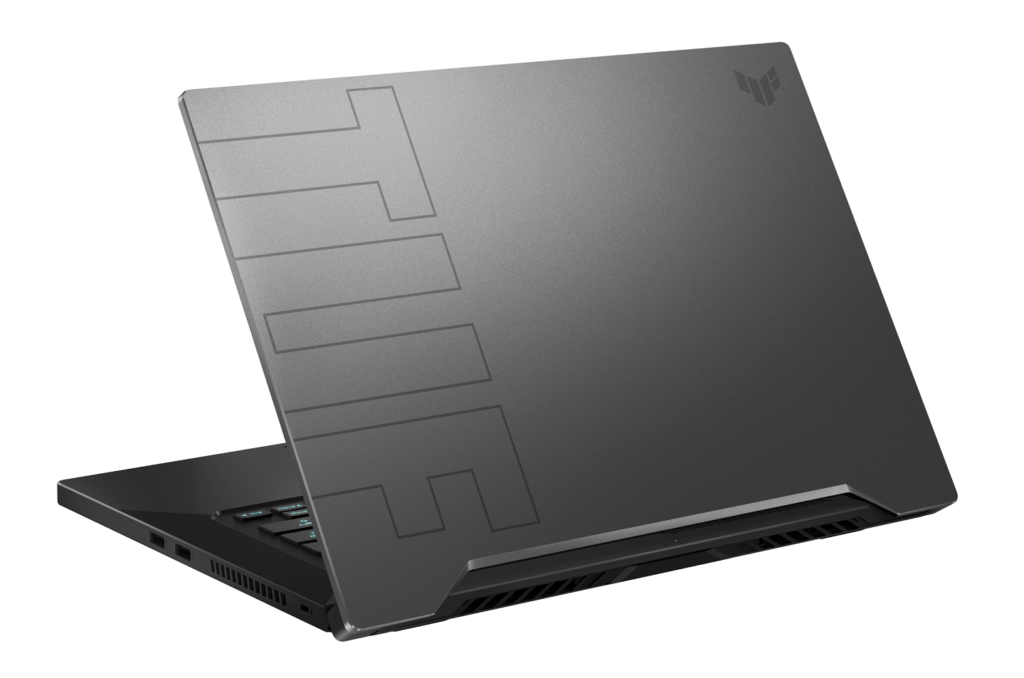
Although it seems like the pairing in the Dash F15 is a bit lacklustre, in actual use it’s still a very competent system. As long as you aren’t using it for intensive video-editing or as an all-in-one streaming device, it’s a very capable machine. In addition to using the in-built display, I hooked up a 1440p and 2160p monitor to run some benchmarks. 2160p at Ultra hovers around 30 fps on most games, but 1440p is definitely a viable option. At the native display resolution of 1080p, results are very good, and you can hit well over 100 fps at Ultra on many games. With a little settings tinkering, you can get almost all games at playable frame rates, and chances are you’ll barely notice the difference from Ultra settings. I am, however, concerned that the low TDP of the GPU, and the 4-core CPU, could hamper this laptop a few years down the line.
Benchmarks
All benchmark tests were carried out with power management and fan control set to Turbo in the Armoury Crate software. For external display tests, I used an Acer Predator XB273U GS 1440p display, and an LG 27UK650 2160p display, connected via HDMI.
Gaming Benchmarks – 1080p
Shadow of the Tomb Raider
- Highest preset – 83 fps
- Highest, RTX on – 57 fps
Forza Horizon 4
- Ultra preset – 114 fps
Gears 5
- Ultra preset – 84.1 fps
Gears Tactics
- Ultra preset – 93.9 fps
Wolfenstein: Youngblood (RTX On)
- Ultra preset – 121 fps
Total War Saga: Troy
- Ultra preset – 81 fps (average across all three scenarios)
Borderlands 3
- Ultra preset – 72.9 fps
Control
- Ultra preset – 122 fps
Control RTX
- Ultra preset – 76 fps
Minecraft RTX
- Ultra preset – 83 fps
Gaming Benchmarks – 1440p
Shadow of the Tomb Raider
- Highest preset – 54 fps
- Highest, RTX on – 40 fps
Forza Horizon 4
- Ultra preset – 88 fps
Gears 5
- Ultra preset – 66.1 fps
Gears Tactics
- Ultra preset – 71.7 fps
Wolfenstein: Youngblood (RTX On)
- Ultra preset – 90 fps
Total War Saga: Troy
- Ultra preset – 64.3 fps (average across all three scenarios)
Borderlands 3
- Ultra preset – 54.81 fps
Control
- Ultra preset – 80 fps
Control RTX
- Ultra preset – 50 fps
Minecraft RTX
- Ultra preset – 67 fps
Gaming Benchmarks – 2160p
Shadow of the Tomb Raider
- Highest preset – 47 fps
- Highest, RTX on – 32 fps
- 32 fps at 4k may not seem significant, but this nearly doubles the 18 fps we recorded on an RTX 2070, highlighting the improved ray-tracing of RTX 30-series GPUs.
Forza Horizon 4
- Ultra preset – 57 fps
Gears 5
- Ultra preset – 51 fps
Gears Tactics
- Ultra preset – 37.5 fps
- This is where the limitations of the CPU really stand out. Based on previous tests, I would have expected in the region of 55-60 fps, but benchmark data shows the CPU to be the limiting factor here.
Wolfenstein: Youngblood (RTX On)
- Ultra preset – 74 fps
Total War Saga: Troy
- Ultra preset – 35 fps (average across all three scenarios)
Borderlands 3
- Ultra preset – 30.78 fps
Control
- Ultra preset – 41 fps
Control RTX
- Ultra preset – 26 fps
Performance comparisons
| Laptop/PC | ASUS ROG Zephyrus Duo SE | Acer Predator Triton 500 | ASUS TUF Dash F15 | Acer Predator Triton 300 | Acer Predator Helios 300 |
| Model | GX551QS | PT515-52 | FX516PR | PT315-52 | PH315-53 |
| Processor | R9 5900HX | i7-10875H | i7-11370H | i7-10750H | i7-10750H |
| GPU | RTX 3080 16Gb | RTX 2080 Super MaxQ 8Gb | RTX 3070 8Gb | RTX 2070 Max-Q 8Gb | RTX 2060 6Gb |
| GPU TGP/TDP | 115W | 85W | |||
| Ram | 32GB DDR4-3200 (16+16) | 32GB DDR4-3200 (16+16) | 16GB DDR4-3200 (8+8) | 16GB DDR4-3200 (8+8) | 20GB DDR4-3200 (16+4) |
| SSD | 2 x 1TB M.2 NVMe SSD | 1Tb M.2 NVMe SSD | 512GB M.2 NVMe SSD | 1Tb M.2 NVMe SSD | 512GB M.2 NVMe SSD |
| HDD | n/a | n/a | n/a | n/a | n/a |
| Display | 2160p 120Hz Pantone | 1080p 300Hz G-Sync | 1080p 144Hz | 1080p 144Hz | 1080p 144Hz |
System Benchmark Results:
As long as you aren’t doing anything too intensive, the TUF Dash F15 will quite happily plug away at basic productivity tasks, video playback and streaming, and regular computer use. Best of all, it uses very little energy, especially when only using the integrated GPU, which means you get outstanding battery life and an almost silent system.
In comparison with the new Ryzen 9 5900H, or even the outgoing i7-10750H (a popular and common laptop gaming laptop CPU), the i7-11370H falls well short in multi-core performance benchmarks. In single-core tests, however, it compares very favourably with the overclocked Ryzen 9 5900HX.
I used the TUF Dash F15 connected to external displays, as well as taking it around the house while doing homeschooling, conferencing and some (lots of) gaming. Thanks to lockdown I couldn’t take it on any commutes, but I’d be happy to use it on the go, confident it has enough power to handle my regular workload as well as some AAA gaming.
CPU Tests:
Cinebench R15
- CineBench – CPU (Single)(cb)
- (High-performance mode / Auto Fan): 234 cb
- CineBench – CPU (Multi)(cb)
- (High-performance mode / Auto Fan): 1096 cb
- CineBench – GPU (OpenGL)
- (High-performance mode / Auto Fan): 136.39 fps
- MP Ratio
- 4.63 x
Cinebench R20
- CineBench – CPU (Single)
- (High-performance mode / Auto Fan): 586
- CineBench – CPU (Multi)
- (High-performance mode / Auto Fan): 2726
- MP Ratio
- 4.65 x
Cinebench R23
- CineBench – CPU (Single)
- (High-performance mode / Auto Fan): 1453
- CineBench – CPU (Multi)
- (High-performance mode / Auto Fan): 6575
- MP Ratio
- 4.53 x
Bright Memory Infinite RTX Benchmark
- Very High – DLSS Setting: Quality
- 1080p: 54 fps
- 1440p: 32 fps
- 2160p: 16 fps
- High – DLSS Setting: Performance
- 1080p: 82 fps
- 1440p: 54 fps
- 2160p: 28 fps
UserBenchMark
- Gaming – 86% Aircraft Carrier
- Desktop – 95% Nuclear Submarine
- Workstation – 79% Battleship
- CPU – Gaming – 81.60%
- Graphics – 106%
- Boot Drive – 194%
Cooling
During our testing, with the Armoury Crate performance mode set to Turbo, the fans, although noisy, did a fantastic job of keeping the internals cool. During a sustained gaming session, the GPU temperature peaked at 78 degrees celsius, while the CPU remained under 88 degrees celsius. Surface temperatures were a little higher than average, though, with the underside, in particular, becoming too hot to be used comfortably on my lap. The important gaming keys never got too warm to be comfortable, though, with the largest heat build-up away from your hands at the top and centre of the keyboard tray.
The heat exhaust at the right side of the display chucks out a fair amount of heat. It was actually quite handy for keeping my mouse-hand warm in the chilly temperatures we’re experiencing, but I was wary of leaving my phone or chocolatey based snacks in the immediate vicinity.
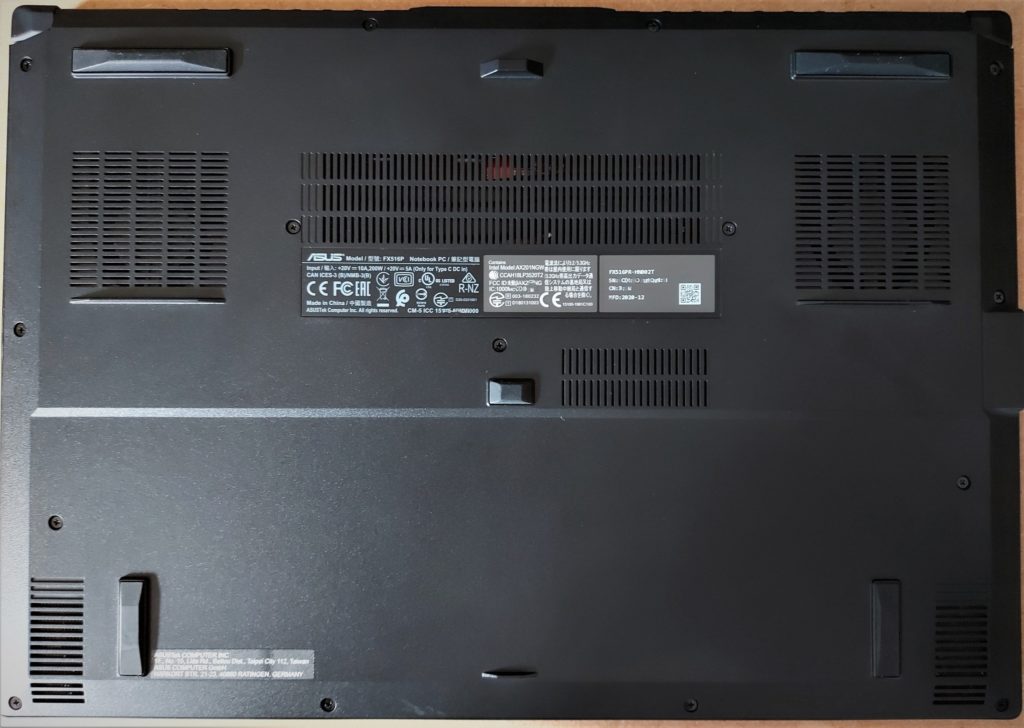
Storage
Our review unit came with a 512 GB M.2 NVMe SSD, which is enough to store a reasonable amount of games. Performance is excellent, with the SSD recording blisteringly fast sequential peaks of 3547 MB/s Read and 2934 MB/s Write. This is above everything we’ve tested with the exception of the Raid 0 configuration of the ROG Zephyrus Duo SE (7111 MB/s read/6005 MB/s write). It makes a noticeable difference compared to slower drives and (God-forbid) regular SATA HDDs.
If you open the rear of the case (very easy to do, thanks to a pop screw that cracks open the case for easy removal), there’s an additional M.2 slot available for storage expansion.
A quick side-note regarding internal upgrades: The TUF Dash F15 has 16 Gb of DDR4-3200 RAM, which is more than enough for the CPU / GPU pairing. If you do need to upgrade it, you can access the RAM when removing the rear panel, however, one of the sticks is soldered in place.
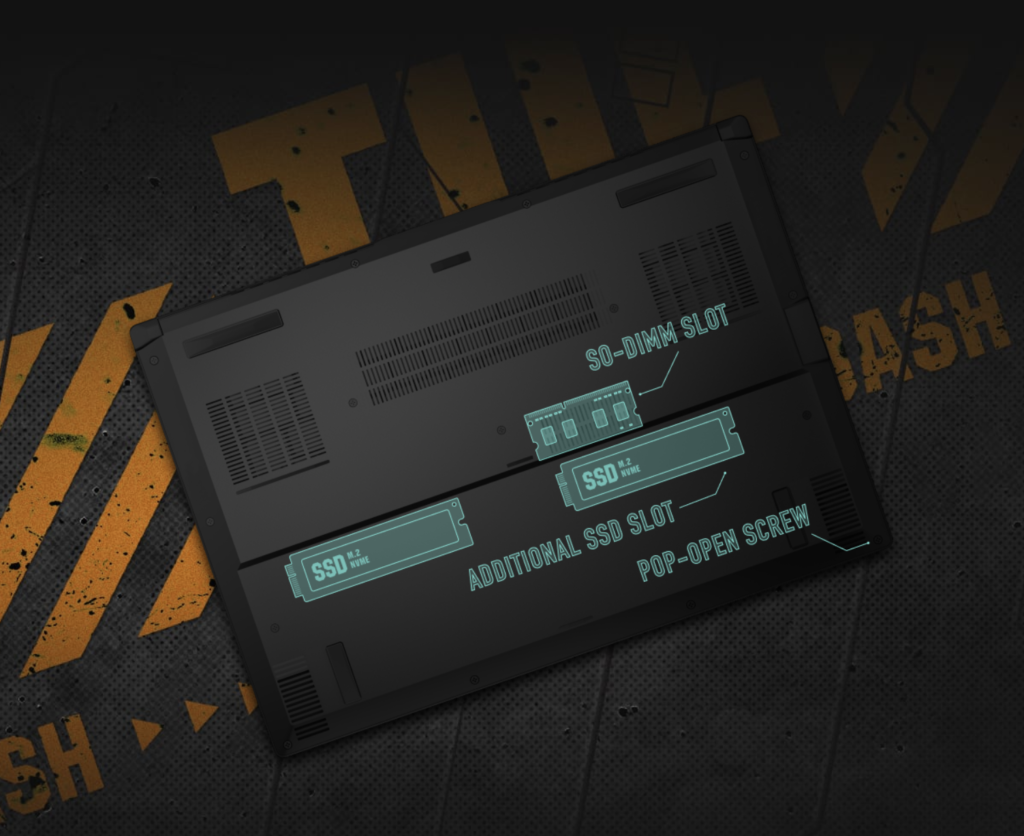
CrystalDiskMark
| SEQ1M Q8T1 Read | 3547.41 |
| SEQ1M Q8T1 Write | 2934.43 |
| SEQ1M Q1T1 Read | 2029.65 |
| SEQ1M Q1T1 Write | 1968.33 |
| RND4K Q321T1 Read | 378.77 |
| RND4K Q321T1 Write | 426.46 |
| RND4K Q1T1 Read | 44.7 |
| RND4K Q1T1 Write | 131.41 |
Battery life
The TUF Dash F15 comes with a very respectable 76WHrs, 4-cell Li-ion battery, that performs better than larger batteries in more power-hungry devices. In absolute power-conserving mode, only using the bare minimum of performance, you can get upwards of 15 hours from the Dash F15, but during our more realistic usage test (including video streaming, web browsing and light productivity), I clocked a solid 6.5 hours of use throughout the day, which is very good.
As ever, gaming on battery power still drains the battery at a rate of knots, but I still managed to play Minecraft RTX for 1 hour 40 minutes before having to plug back in (60 fps, power-saving turned on, 50% brightness, plugged in with 17% remaining). By adjusting the settings, you can run with the frame rate capped between 30 and 60 fps dependant on how long you need to stretch out your battery life.
The included 200W slimline charger will take the Dash F15 from 25% to 100% in just under an hour. You can also charge it with USB-C, however, it will be considerably slower and you won’t be able to take advantage of the full power of the laptop in Turbo mode, like when connected to the mains supply.
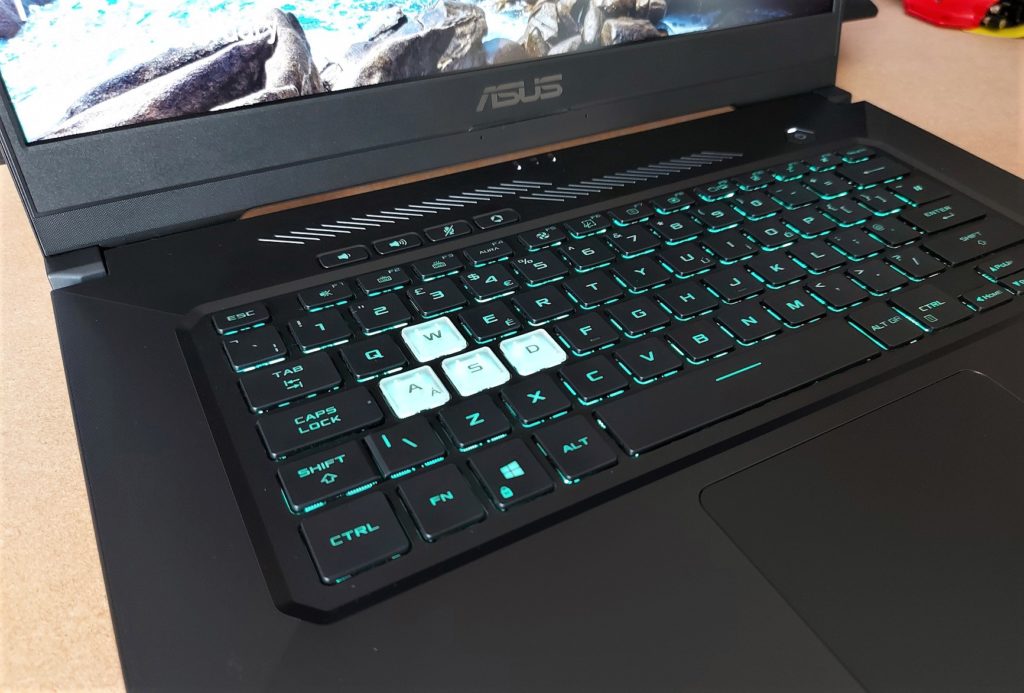
Who is the ASUS TUF Dash F15 best suited for?
If your primary need is for long battery life to keep you working through the whole day, but still want to be able to play the newest games, then the TUF Dash F15 may be just what you are looking for. This is, of course, a very specific target audience, but if you are a student or use your laptop for work during the day away from plug sockets, it’s a solid choice. However, if your primary aim is the best gaming performance, knowing that there are RTX 3060 laptops out there that can comfortably outperform your 3070 is a bitter pill to swallow.
Summary
If you are in the niche where battery life is the most important consideration, the TUF Dash F15 has incredible longevity that should easily last a full day’s work, and its slim and light design is great for portability. Build quality is excellent, and I like the new design aesthetic of the new TUF laptops, but the poor sRGB coverage is disappointing, as is the underperforming GPU. At the asking price of £1299, though, it still represents great value for money, and even though performance is only incrementally better than the previous-gen, you can pick up the Dash F15 for less than the laptops it is replacing.


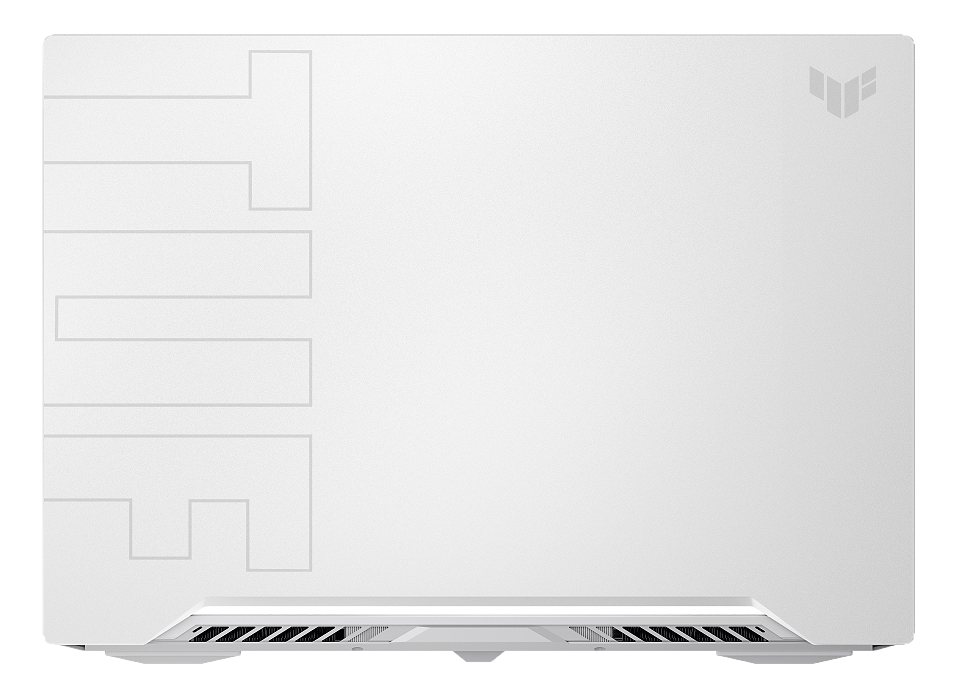
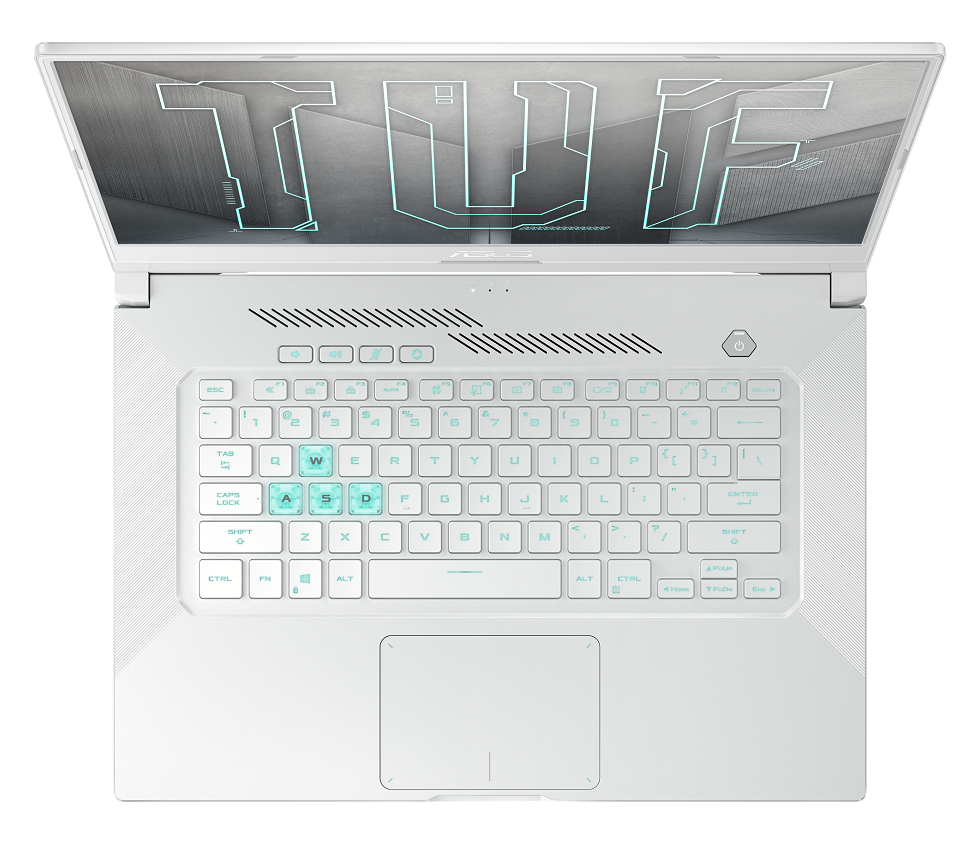
ASUS ROG Zephyrus Duo SE GX551QS (2021) Review | Total Gaming Addicts
14th February 2021 at 3:29 pm[…] received both the ASUS TUF Dash F15 and the Zephyrus Duo SE to review, which was my first experience with the new RTX 30-series GPUs. […]
Acer Predator Orion 5000 PO5-615s (2021) Review | Total Gaming Addicts
15th March 2021 at 9:53 pm[…] ASUS TUF Dash F15 […]